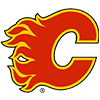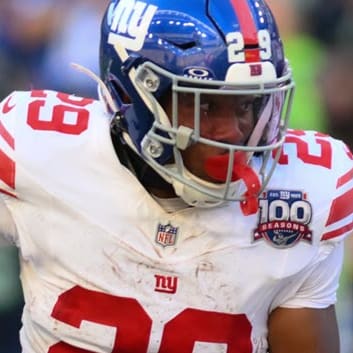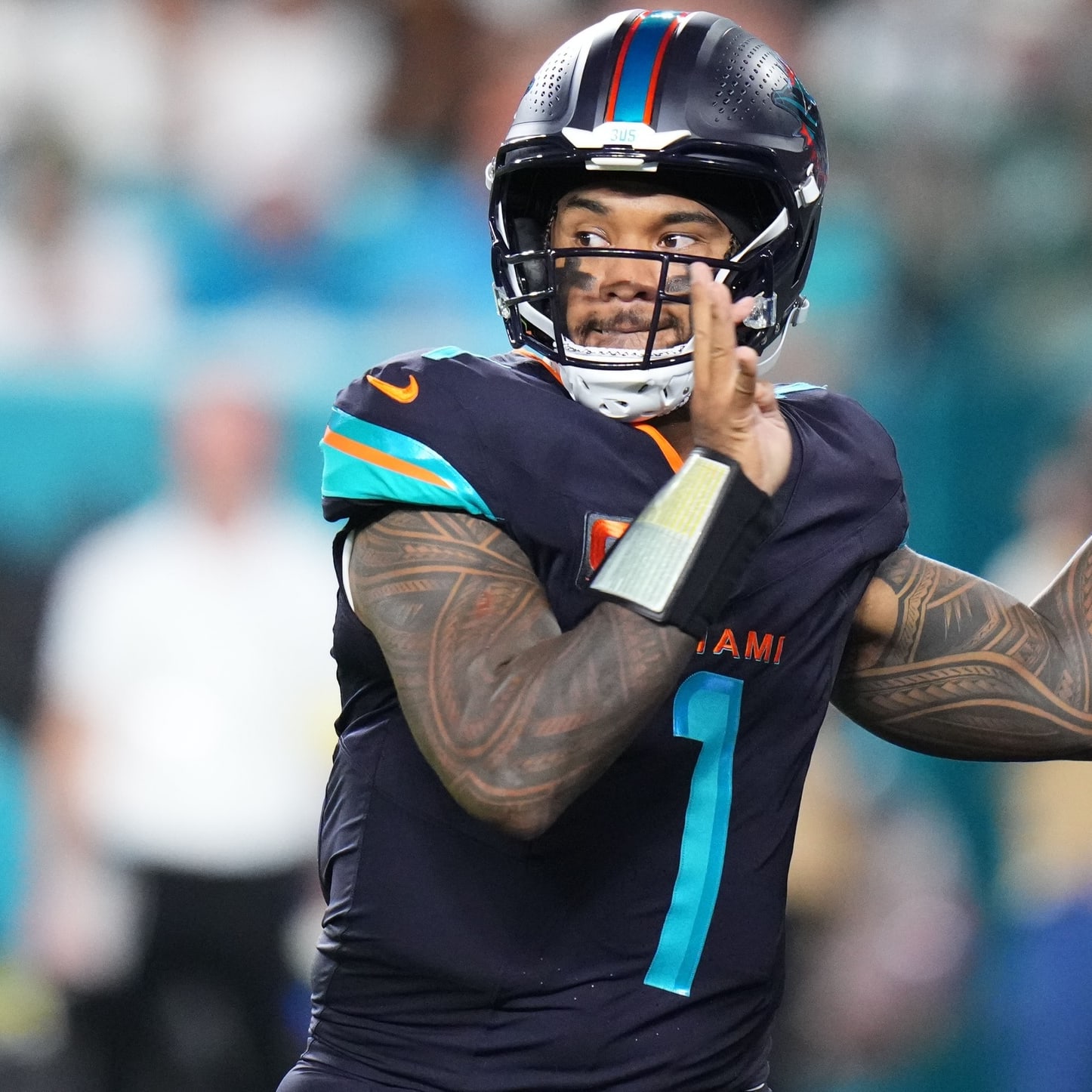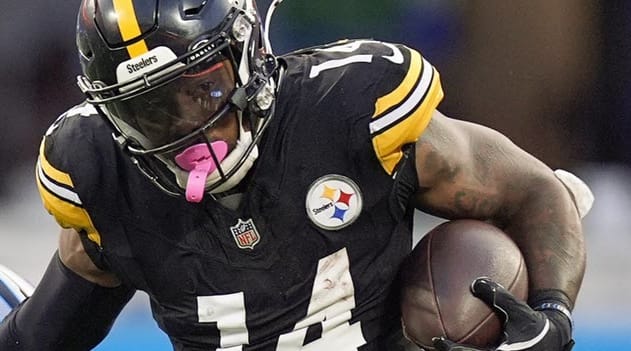With training camp nearing an end and rookies having finally gotten a chance to work alongside teammates, there's plenty to consider when looking at current value trends. In this article we take one last look at how the dynasty community is looking at this year's class, and how savvy managers might pivot. Players are listed with age and ranked by August MFL ADP.
1. Clyde Edwards-Helaire, 21, RB, KC (5-7, 207) 1st round, 32nd overall
I expect Jonathan Taylor to have the better career, so I wouldn't fault anyone for taking Indianapolis' presumed bell cow at this spot over Edwards-Helaire. Their respective situations, with Damien Williams' opt out paving the way for CEH to play an immediate No. 1 role while Taylor has to deal with Marlon Mack and Nyheim Hines siphoning touches, makes me confident that CEH will enjoy a better rookie year. Between the two, Edwards-Helaire probably will carry the higher ADP value this time next year, making him an easy top choice.
My rank: No. 1
2. Jonathan Taylor, 21, RB, IND (5-10, 226) 2nd round, 41st overall
I don't think it'll happen, but coach Frank Reich has been both consistent and vocal in his statements that Marlon Mack and Jonathan Taylor will split the load. For my money, a Nick Chubb/Carlos Hyde 2018 scenario as the probable outcome is far more likely than a Derrick Henry/DeMarco Murray 2016 situation, but the fact that a committee can't be entirely ruled out drops Taylor a notch below CEH. Plus, Nyheim Hines is unlikely to be usurped in passing scenarios.
My rank: No. 2
3. J.K. Dobbins, 21, RB, BAL (5-9, 209) 2nd round, 55th overall
Dobbins brings a three-down skillset, standout lateral agility, breakaway speed and tackle-breaking affinity to the NFL's premier rushing team. There's an argument to be made that his landing spot is as prime as Edwards-Helaire or Taylor's, with the only caveat being Mark Ingram's presence. The 30-year-old could realistically limit Dobbins to a committee Year 1, but Baltimore's offense is potent enough that such a role would still offer upside, and the team has a potential out in Ingram's contract after this season. Dobbins won't be suppressed from the lead role for long.
My rank: No. 4
4. D'Andre Swift, 21, RB, DET (5-8, 212) 2nd round, 35th overall
Swift's hallmark traits are steady hands, vision and elusiveness, and his 4.48 40-yard dash is nothing to scoff at either. The Georgia product paints a clear picture of every-down potential, though he could begin behind Kerryon Johnson as a rookie after having been hampered by injury throughout training camp. Even if Swift gets off to a slow start, he's by far the closest thing to a complete back on this roster, and getting the backfield going should be a clear priority for the Lions.
My rank: No. 5
5. Cam Akers, 21, RB, LAR (5-10, 6-2) 2nd round, 52nd overall
Akers appears positioned to begin his career in a dreaded backfield-by-committee, but he has the talent to usurp the likes of Malcolm Brown and Darrell Henderson en route to an eventual three-down role. A powerful runner with burst and proficient receiving chops, Akers is moving from one poor O-line to another, which is a major concern. Florida State's abysmal blocking gave Akers a non-existent margin for error in college, and the Ram's protective front kicks off 2020 in the back 20 of our rankings.
My rank: No. 7
6. CeeDee Lamb, 21, WR, DAL (6-2, 198) 1st round, 17th overall
Lamb pairs elite ball skills with fluidity, explosiveness and elusiveness, traits that more than make up for his sub-optimal combine testing. He's not a perfect prospect, as he'll have to improve his route running in the pros and adjust to a level of physicality where he has to do more to win, but Lamb has all the tools to live up to his "88" jersey number. Even with two established high-end starters already in Dallas, Lamb has a path to relevance as a rookie due to the offense's high pass volume and 190 vacated targets
My rank: No. 3
7. Jerry Jeudy, 21, WR, DEN (6-1, 193) 1st round, 15th overall
Jeudy and Lamb are in lockstep as the most talented receivers in what could be a historic class, but similarly to the top tier of CEH and Taylor, minor questions serve as a tiebreaker. Even with Courtland Sutton having emerged as the team's clear No. 1, Jeudy's athleticism, burst and tremendous route-running will make him an immediate impact player. Whether Drew Lock can conjure fantasy relevance for Sutton, Jeudy and Noah Fant — not to mention fellow rookie KJ Hamler and the Broncos' backfield options — remains to be seen.
My rank: No. 6
8. Jalen Reagor, 21, WR, PHI (5-11, 206) 1st round, 21st overall
Poor QB play alleviates concerns regarding Reagor's relative lack of production at TCU, as does an ideal landing spot in Philadelphia. Reagor brings a rare combination of burning speed, smooth and varied routes, and capable contested catch ability to Philadelphia's receiving corps, and he's well positioned to immediately start opposite DeSean Jackson once he puts his shoulder injury behind him. There's a lot of room for Reagor to grow, particularly with regard to refining concentration and fully living up to his athletic potential, so if his development goes as planned the Eagles could emerge with a true No. 1 WR.
My rank: No. 8
9. Justin Jefferson, 21, WR, MIN (6-1, 202) 1st round, 22nd overall
Jefferson's outstanding athleticism, vision and ability to adjust mid-route gives the Vikings exactly the immediate-impact type of playmaker necessary to fill the void of Stefon Diggs. He does seem most attuned to the slot, where Adam Thielen is most effective, but both of Minnesota's top options boast enough versatility to function on the outside. LSU's scheme did a fine job manufacturing separation and targets for Jefferson, but he'll need to conjure his own in Minnesota. A run-first scheme, and the fact that Bisi Johnson offers stronger competition than most dynasty owners might think, are red flags.
My rank: No. 15
10. Henry Ruggs, 21, WR, LVR (5-11, 188) 1st round, 12th overall
Ruggs could drop in ADP if the hype on rookie teammate Bryan Edwards reaches a fever pitch, a prospect with his talent shouldn't fall far. In addition to blazing speed, Ruggs showcased a full route tree in college, and he'll immediately slot in not only as Las Vegas' big-play threat, but also as a receiver with consistent weekly targets all over the field. Ruggs isn't nearly in the mold of Tyreek Hill or DeSean Jackson yet, but he's much closer to that than the Dorial Green-Beckham end of the spectrum.
My rank: No. 9
11. Joe Burrow, 23, QB, CIN (6-3, 221) 1st round, 1st overall
Burrow was a no-brainer for Cincinnati at No. 1 overall coming off a historically dominant season, and he's a similarly easy selection in dynasty drafts. His list of positives includes accuracy, consistency, creativity and processing speed, and his knocks — fair arm strength and a slight tendency to hold on to the ball — are comparatively minor. Lock in Burrow alongside Taylor and CEH at the top of superflex drafts, but in one-QB leagues the No. 11 pick is quite rich. Modest rushing upside and a solid supporting cast even position Burrow well for fantasy relevance as a rookie, but at the back of the first of a loaded class, I'd have to be more confident in a top-5 career path to draft him here.
My rank: No. 20
12. Michael Pittman, 22, WR, IND (6-4, 223) 2nd round, 34th overall
Once upon a time I had the satisfaction of beating the drum for Pittman while he fell to the mid-second in drafts, but now it seems consensus ADP and my own enthusiasm have met at a comfortable middle. Big-bodied, pro ready and with above-average athleticism and traits, Pittman should slot in as an immediate starter in Indianapolis' offense. He's logged consistent work with the first-team offense throughout training camp and presumably built a rapport with Philip Rivers, so the expectation should be for Pittman to immediately push for a starting role in three-wide sets. For now, he profiles as a solid complement to T.Y. Hilton, but his upside is to eventually usurp the No. 1 gig.
My rank: No. 12
13. Tee Higgins, 21, WR, CIN (6-4, 216) 2nd round, 33rd overall
Penciling Higgins in as the "replacement A.J. Green" was almost too easy after Cincinnati grabbed him with the first pick in the second round, but the label nonetheless looks accurate. Higgins makes up for average athleticism with a 6-4 frame, exceptional balance and strong body control that lends to contested-catch dominance. Despite a lack of top-end speed he tracks the deep ball well, giving him the ability to line up all over the field. He's likely to carve out a starting role alongside Green and Tyler Boyd at some point Year 1, and the presence of two steadfast veterans should help disguise Higgins' less-than ideal route tree while he works to grow.
My rank: No. 18
14. AJ Dillon, 21, RB, GB (6-0, 247) 2nd round, 62nd overall
Dillon ranked at 14 is a clear indication of this draft class' evident strength, as there'd be an argument for him in the mid- to late-first most years. Despite not boasting pass-catching chops or much elusiveness, Dillon's bulk, speed and vision make him a rare backfield weapon — and an ideal thunderous complement to Aaron Jones, who still stands to dominate carries for another year. It's possible that Dillon will always be doomed to sharing the load with a more capable pass catcher, but if Jones and Jamaal Williams both depart in 2021, the 247-pound siege weapon is a near lock to dominate red zone opportunities.
My rank: No. 16
15. Ke'Shawn Vaughn, 23, RB, TB (5-10, 214) 3rd round, 67th overall
Vaughn put together a 25 percent target share at Vanderbilt despite maxing out at 28 catches in a single season, and he managed two 1,000-yard campaigns in the SEC. Linking with a quality coaching staff in Tampa Bay is also a plus, but the 23-year-old's already-unclear path to carries now becomes almost entirely marginalized following the signing of Leonard Fournette. Vaughn was always overdrafted, but the pendulum could now swing around and make him a worthwhile stash candidate — if he falls to the third-round range.
My rank: No. 30
16. Brandon Aiyuk, 22, WR, SF (6-0, 205) 1st round, 25 overall
Aiyuk's red flags are numerous: a lacking collegiate route tree, just one year as a full-time D1 starter, average speed and unproven skills against press coverage. He more than compensates with first-round draft capital, an abundance of Year 1 opportunities and elite yards-after-the-catch athleticism. A hamstring injury may prevent him from taking immediate advantage of Deebo Samuel's foot injury, but when both WRs return to full health they should form a dangerous tandem.
My rank: No. 13
17. Denzel Mims, 22, WR, NYJ (6-3, 207) 2nd round, 59th overall
The last thing a top-end athlete with lean-frame route-tree concerns needs in his rookie season is limited practice reps. Unfortunately for Mims, a hamstring injury has kept him sidelined since the start of training camp, and in an offseason already severely lacking for in-person work. The Baylor standout looks on track for Week 1, but a lack of reps could exacerbate the already steep challenge of adjusting to NFL-level coverage from the Big 12. An immediate path to start somewhat balances out those concerns.
My rank: No. 21
18. Zack Moss, 22, RB, BUF (5-9, 223) 3rd round, 86th overall
Moss boasts an ideal skillset to not only fill the goal-line role left by Frank Gore, he also has the ability to replicate Devin Singletary's effectiveness in the passing game and picking up yards after contact. Although he lacks elite speed, Moss' strong training camp looks to have propelled him beyond a backup gig and into a 1a/1b timeshare straight out of the gate. If Singletary's camp struggles with fumbling continue, there's even room for a scenario in which Moss emerges as the lead option. RB-needy teams can feel justified in reaching for the Utah product.
My rank: No. 10
19. Antonio Gibson, 22, RB, WAS (6-0, 228) 3rd round, 66th overall
Gibson's stock will continue to balloon as the season approaches, with Derrius Guice and Adrian Peterson both having been released in August. Expectations for Gibson should be tampered out of the gate, as he didn't come into the league pro-ready and doubtlessly will need more time to pick up intricacies, but he's now in a prime scenario to earn relevant touches. New coach Ron Rivera is no stranger to manufacturing touches, having done so for Christian McCaffrey, Curtis Samuel and D.J. Moore in Carolina, and Gibson is the only member of this backfield that the new regime hand-selected. Bryce Love could also be more of an eventual threat than most seem to expect, barring injury setbacks.
My rank: No. 11
20. Tua Tagovailoa, 22, QB, MIA (6-0, 217) 1st round, 5th overall
Ryan Fitzpatrick is locked in as the Week 1 starter, with Tagovailoa not yet having looked game-ready in camp. The Alabama product is coming off multiple significant injuries, so it wouldn't be any surprise for the team to take ample time bringing him along. The plus side is that Fitzpatrick should bear the brunt of difficulties as an offensive line with four new starters works to mesh, while coming off an offseason of shortened in-person drills. In superflex/2-QB formats, grab Tagovailoa with confidence at any range in the first round, but don't pass on solid WR/RB options in non-premium formats.
My rank: No. 23
21. Laviska Shenault, 21, WR, JAC (6-1, 227) 2nd round, 42nd overall
Shenault faces a crowded depth chart on paper, but in practice his after-the-catch abilities, versatility and athleticism should quickly allow him to challenge Dede Westbrook for the No. 2 gig. His skillset lends well to usage in the short and intermediate passing game, a valuable area of the field in offensive coordinator Jay Gruden's scheme. With the departure of Leonard Fournette, Shenault's history of snaps out of the backfield could actually have a chance at translating to the pro level: his 42 carries and seven rushing touchdowns at Colorado could foretell of usage similar to what Deebo Samuel saw in 2019.
My rank: No. 17
22. Bryan Edwards, 21, WR, LVR (6-3, 212) 3rd round, 81st overall
Edwards was a quick riser in August due to daily praise-pieces coming out of Raiders camp, and Tyrell Williams' season-ending injury will doubtless send his stock even higher. Elite breakout age, strong college production and impressive tape all work in Edwards' favor, and his draft capital comes with the caveat of having fallen due to injury. Edwards looks like a player who should quickly translate at the pro level, and much of Las Vegas' success on offense will come down to how well he and fellow rookie Henry Ruggs are able to adapt to starting workloads Year 1.
My rank: No. 14
23. Anthony McFarland, 22, RB, PIT (5-8, 208) 4th round
McFarland immediately steps into Pittsburgh's backfield as the fastest option in the room, and there was early optimism that he would win the No. 2 role as a rookie. Benny Snell's tremendous offseason has put a damper on those hopes, but McFarland could still slot in as a change-of-pace back. If James Conner again struggles to stay healthy, that role could increase enough to provide fantasy relevance.
My rank: No. 35
24. Chase Claypool, 22, WR, PIT (6-4, 238) 2nd round, 49 overall
Claypool likely would need to overtake James Washington as the No. 3 receiver to carve out fantasy relevant as a rookie, an unlikely outcome even if he has earned constant praise during training camp. As a generational athlete with an almost unheard of combination of speed and size, of course, Claypool's upside was always developmental. If he can flash in limited opportunities as a rookie, he could inspire the Steelers to part ways with Eric Ebron after this season, instead slotting in Claypool as the team's predominant red-zone target.
My rank: No. 24
25. Darrynton Evans, 22, RB, TEN (5-10, 203) 3rd round, 93rd overall
Evans doesn't have a realistic shot to eat into Derrick Henry's workload, essentially leaving him with upside only as a handcuff. Were Evans to get a shot, however, he possesses the explosiveness and record of college production to get the job done. A number of the options going behind him should possess clearer paths to relevance, and likely higher upside, but an early third-round rookie pick isn't a terrible price to pay for the No. 2 option in a valuable backfield.
My rank: No. 26
26. Joshua Kelley, 22, RB, LAC, (5-11, 212) 4th round, 112th overall
Kelley's ceiling for the foreseeable future is as a complement to Austin Ekeler, but that's a role that would carry real value. No other back in this group boasts the frame that Kelley does, but he'll face strong competition out of the gate from Justin Jackson. However, Jackson has struggled with injuries in his career and missed time in training camp due to a foot issue, so a quick path for Kelley to establish himself could be in the cards.
My rank: No. 28
27. Justin Herbert, 22, QB, LAC, (6-6, 236) 1st round, 6th overall
Herbert isn't the pro-ready prospect that Joe Burrow and Tua Tagovailoa look to be, but his fantasy prospects could get a boost with his rushing upside. He'll begin his career with an opportunity to refine his traits as a passer behind Tyrod Taylor, and but when Herbert does enter the starting lineup he'll get the additional benefit of an outstanding receiving corps. His mobility could also lessen the impact of a below-average offensive line.
My rank: No. 27
28. KJ Hamler, 21, WR, DEN (5-0, 178) 2nd round, 46 overall
The only real knock on Hamler is target opportunity, as he checks the boxes of draft capital, breakout age, production and athleticism. Courtland Sutton and Jerry Jeudy rank ahead of Hamler in the pecking order, and it's possible that Noah Fant and Melvin Gordon could each also command superior targets. Even if steady looks can't go his way, the speedster could immediately contribute as a returner if he's able to shed his hamstring injury in the near future. He's a great long-term stash at this point in the draft.
My rank: No. 25
29. Cole Kmet, 21, TE, CHI (6-6, 262) 2nd round, 43rd overall
Kmet will get every opportunity in Chicago, and he profiles as more of a fantasy-friendly pass catcher than a run blocker, but the Bears seem intent on beginning him as a blocker while Jimmy Graham lines up wide. Tight ends are already unlikely to bring fantasy relevance early in their careers, and Kmet's path will be blocked by Graham, but he should at least see the field often. Unless Chicago's quarterback play rebounds, though, that role may have minimal value.
My rank: No. 34
30. Van Jefferson, 24, WR, LAR (6-1, 200) 2nd round, 57th overall
Jefferson was my favorite target in the third round of rookie drafts in May, and training camp reports are doing a fair job of justifying my abundant shares. It's no surprise that dynasty players weren't enchanted by a 24-year-old who never even put up a 700-yard season in the SEC, but it's hard to justify Jefferson falling so far. He's in the conversation with the most polished receivers of the entire draft class, and I expect him to beat out Josh Reynolds for the No. 3 job early.
My rank: No. 19
31. Devin Duvernay, 22, WR, BAL (5-11, 200) 3rd round, 92 overall
Duvernay's landing spot is outstanding, with an open depth chart and where low passing volume should be balanced out by target value. Late breakout age or no, the yards-after-catch specialist is more than talented enough to eventually usurp Willie Snead as the top slot wideout. If Duvernay can flash enough as a rookie to earn the coaching staff's confidence heading into 2021, he could emerge as a similar player to Golden Tate. Like Van Jefferson, Duvernay shouldn't be falling to the third round of rookie drafts. He's already got a standout training camp in his favor.
My rank: No. 22
32. Antonio Gandy-Golden, 22, WR, WAS (6-4, 223) 4th round, 142nd overall
Gandy-Golden could very realistically earn a starting job as a rookie, following Kelvin Harmon's season-ending injury. Steven Sims and Trey Quinn will operate out of the slot, leaving room for Gandy-Golden to work outside alongside Terry McLaurin. Opportunity in a poor offense is opportunity nonetheless. However, aside from his spectacular contested-catch abilities, Gandy-Golden is unrefined in most areas. He'll have the chance to make an impact if he can upgrade his release, route running and balance, but that's hardly a guarantee.
My rank: No. 33
33. Lynn Bowden, 22, RB, LVR (5-11, 204) 3rd round, 80th overall
Bowden's quiet training camp is a bit disconcerting, as are the plethora of change-of-ace backs that the Raiders also roster. Josh Jacobs will command workhorse-level carries while Jalen Richard handles substantial passing downs. Losing Tyrell Williams for the season could open a lane for Bowden to see real snaps at WR, but I expect him to predominantly work out of the slot, where Hunter Renfrow and Henry Ruggs will be prioritized. Bowden could emerge as the team's top return specialist, but that's not a huge factor in most fantasy formats.
My rank: No. 32
34. Jordan Love, 21, QB, GB (6-4, 224) 1st round, 26th overall
Love's raw talent is undeniable, but it's the finer aspects of his game that made him fall all the way to the end of the first round. On paper, however, the opportunity to learn as the backup of a future Hall of Famer for a couple years seems like the perfect situation for Love. If Green Bay's coaching staff can refine Love, whittling away the bad habits he picked up in 2019 while maximizing his arm talent and athleticism, his upside is as high as any other signal-caller in this class. Expect Love to sit at least two seasons, but in multi-QB formats I'm willing to take him at any range in the second round.
My rank: No. 40
35. Adam Trautman, 23, TE, NO (6-5, 255) 3rd round, 105th overall
Trautman did what one with his dominant frame would be expected to against FCS competition at Dayton, but the transition from small school to the NFL is notoriously difficult, especially for tight ends. He has the luxury of sitting behind Jared Cook, however, and learning in an environment that knows how to utilize his position.
My rank: No. 41
36. Devin Asiasi, 23, TE, NE (6-3, 257) 3rd round, 91st overall
If it weren't for New England drafting fellow rookie TE Dalton Keene later in the same round, Asiasi would probably be going much earlier. As is, there's reason for cautious optimism. Asiasi has plus traits but will need time to develop, though Keene isn't an insignificant threat. It's easy to envision a long-term path to success for Asiasi, but the gap between he and Keene should be closer. Both have a wide open depth chart and ideal landing spot.
My rank: No. 36
37. Eno Benjamin, 21, RB, ARI (5-9, 207) 7th round, 222nd overall
Draft capital, depth chart position and size are big enough red flags that I'd pass on Benjamin here, despite liking his college tape. Short-term expectations should be minimal, though there's a chance he could find himself in good position in 2021 — assuming the Cardinals let Kenyan Drake walk, and Benjamin makes a good impression on the coaching staff.
My rank: No. 50
38. La'Mical Perine, 22, RB, NYJ (5-11, 216) 4th round, 120th overall
Perine is a solidly average athlete with above average traits. He boasts good size, vision, patience and balance, in addition to receiving skills that could produce easy fantasy value. It's difficult to imagine him garnering more than occasional playing time as a rookie unless Le'Veon Bell goes down, of course, and even then he'd be tasked with taking carries from Frank Gore.
My rank: No. 31
39. Tyler Johnson, 22, WR, TB (6-1, 206) 4th round, 161st overall
Scott Miller offers strong competition for Tampa Bay's third-receiver job, and whoever wins will be fighting for scraps behind Mike Evans, Chris Godwin, Rob Gronkowski, O.J. Howard and likely even a running back.
My rank: No. 48
40. Jalen Hurts, 21, QB, PHI (6-2, 218) 2nd round, 53rd overall
It's difficult to draft a narrative in which Hurts sees enough playing time behind Carson Wentz to maintain fantasy relevance, barring the continuance of unlucky injuries. The chances of him mimicking Taysom Hill's path to success aren't enough to bet on. That said, in multi-QB formats his athletic prospects are enough to convince me to take a lottery ticket.
My rank: No. 43
41. DeeJay Dallas, 21, RB, SEA (5-10, 217) 4th round, 144th overall
Chris Carson, Carlos Hyde and Rashaad Penny (knee) are clearly solidified above Dallas on the depth chart, but none is an example of picturesque health. Dallas displayed soft hands as a receiver in college despite not logging outstanding production. The fact that Carson and Hyde are set to become unrestricted free agents in 2021 is one of Dallas' major points of interest.
My rank: No. 39
42. Quintez Cephus, 22, WR, DET (6-1, 202) 5th round, 166th overall
By all accounts out of Lions camp, Cephus has been impressive right out of the gate. His game combines outstanding contested-catch ability with above-average separation — a skillset that, admittedly, often doesn't translate from college to the pros. His strong camp appears to be confirming all the positives he put up on tape, though, and most notably offers a hint that he could successfully be improving his route running. Subpar draft capital and a dismal 40 time are red flags, but Cephus has the talent to take advantage of the opportunities he should see in 2021.
My rank: No. 29
43. Jacob Eason, 22, WB, IND (6-6, 231) 4th round, 122 overall
A former five-star recruit, Eason's arm talent is as undeniable as his lack of polish. Injuries and a transferring only left room for him to start one full season in college, and it's evident on tape that Eason didn't progress enough in his development to reliably handle the pocket breaking down. That said, Indianapolis looks like an ideal spot for him to redshirt as a rookie and develop. He's an ideal stash in superflex leagues, especially on a taxi squad.
My rank: No. 47
44. Donovan Peoples-Jones, 21, WR, CLE (6-2, 212) 6th round, 187th overall
It would be surprising if Higgins isn't locked in to the No. 3 receiver role for at least 2020, but that isn't much of a knock on Peoples-Jones, considering how much time he'll likely need to get pro-ready. He has athleticism, size and catch radius on his side, but he'll need plenty of refinement before making more than occasional appearances on the field. A top-ranked high school prospect, Peoples-Jones only eclipsed 500 receiving yards once during three seasons at Michigan. His quickest path to on-field action may be as a return man.
My rank: No. 54
45. Gabriel Davis, 21, WR, BUF (6-2, 216) 4th round, 128th overall
Davis has traits that Buffalo's receiving corps needs, and his long speed should make him capable both in the slot and outside. The UCF standout is coming off back-to-back productive seasons, each of which built upon the last, giving him the desired upward trend for a wideout who just turned 21. His college routes were too sloppy for the pro level, but reports that Davis had been a standout at camp imply that he's been very receptive to NFL coaching. Having cushion to develop behind veteran starters could be a blessing in disguise for Davis.
My rank: No. 38
46. Albert Okwuegbunam, 22, TE, DEN (6-5, 258) 4th round, 118th overall
Although he's coming off an unproductive season at Missouri, Okwuegbunam checks major boxes as a prospect. Athletically he boasts a 99th percentile 40 time, and he put up 415 yards and 11 scores as a true freshman (before turning 20). Okwuegbunam will quickly slot in as the No. 2 tight end behind Noah Fant, giving him a clear path to playing time even if target opportunities are more obscured. Plus, joining former college teammate Drew Lock is an advantage with a shortened offseason.
My rank: No. 42
47. Dalton Keene, 21, TE, NE (6-4, 253) 3rd round, 101st overall
Keene's college production was minimal, but he displayed effortless pass-catching abilities when healthy. He got significant investment from New England even if Devin Asiasi was selected first, and film shows a smart player. Going to arguably the best possible landing spot for a tight end provides Keene with a real value boost, but he'll need to improve his route running and blocking technique at the next level. Measurable reminiscent of Blake Jarwin.
My rank: 36
48. James Robinson, 22, RB, JAC (509, 219) UDFA
The departure of Leonard Fournette gives Robinson exactly the opportunity he needed to make the final roster, but he's still a lottery ticket. In his final two seasons at Illinois State he nearly put up 3,200 rushing yards with 30 touchdowns, and he displayed explosiveness at the combine in most areas, though his 4.64 40-yard dash time is unimpressive.
My rank: No. 44
49. Joe Reed, 22, WR, LAC (6-1, 215) 5th round, 151st overall
Reed has taken snaps at both RB and WR during training camp, hinting that he could possess coveted dual-threat capabilities. The Chargers could have some snaps up for grabs at both positions in 2020.
My rank: No. 55
50. Thaddeus Moss, 22, TE, FA (6-2, 250) UDFA
Let someone else grab the undrafted rookie tight end who's a free agent after being waived by Washington with a foot injury. Even if he hits at some point, odds are you don't hold him for long enough to reap those rewards.
My rank: No. 61
Names outside the top-50 ADP to consider:
John Hightower, 24, WR, PHI (6-2, 189) 5th round, 168th overall
The speedy rookie put forth an impressive training camp, and injuries could give him an opportunity to see the field early. The Eagles will need to replace DeSean Jackson sooner than later.
My rank: No. 46
Darnell Mooney, 22, WR, CHI (5-10, 176) 5th round, 173rd overall
May be limited to special teams early on, but the prototypical slot receiver's strong training camp should guarantee him at least a practice squad spot, if not a chance on the roster.
My rank: No. 51
JaMycal Hasty, 22, RB, SF (5-8, 205) UDFA
Hasty has flashed in limited practice opportunities. He could cling to a depth role in one of the league's most valuable backfields.
My rank: No. 56
K.J. Hill, 22, WR, LAC (6-0, 196) 7th round, 220th overall
Ohio State's all-time leading pass catcher is stuck in an offense that hasn't provided any value to the No. 3 WR in recent years, but he could have opportunities if Mike Williams (shoulder) ends up on the latter end of his recovery timeframe.
My rank: No. 53
Harrison Bryant, 22, TE, CLE (6-5, 243) 4th round, 115th overall
The 2020 Maurice Basset award for best rookie at camp, Bryant could push David Njoku in an offense that figures to be among the leaders in two-TE sets.
My rank: No. 45
Quez Watkins, 22, WR, PHI (6-0, 185) 6th round, 200th overall
Watkins has an under-the-radar profile of collegiate production, and he impressed with a 4.35 40-yard dash at the combine. However, it's a red flag that fellow rookie deep threat John Hightower outplayed Watkins in training camp.
My rank: No. 49
Isaiah Coulter, 21, WR, HOU (6-2, 198) 5th round, 171st overall
Houston's deep WR corps will give Coulter the time he needs to develop. He's athletic with potential upside playing outside, and a good target in leagues with taxi squads.
My rank: No. 52
Isaiah Hodgins, 21, WR, BUF (6-4, 210) 6th round, 207th overall
Hodgins was the second big-bodied rookie wideout that Buffalo selected in April, but it looks like fifth-round pick Gabriel Davis is clearly in the lead for the No. 4 spot.
My rank: No. 57
Salvon Ahmed, 23, RB, MIA (5-11, 197) UDFA
A talented between-the-tackles runner whose 4.62 40-yard dash tanked his prospects. Ahmed is a longshot in Miami, but he's a match for the scheme.
My rank: No. 58
Jake Fromm, 22, QB, BUF (6-2, 219) 5th round, 167 overall
Fromm doesn't need to be considered in 1-QB leagues, but in superflex/2-QB there are worse fliers.
My rank: No. 59











































